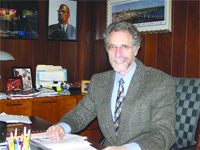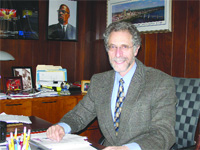
The Numbers Game
Public Colleges See Applications Soar, Budgets Fall

STCC President Ira Rubenzahl says that, even with student cost increases imminent, public higher education will continue to offer good value.
Glib pundits like to chart the economy with some interesting bellwethers: in a bear market, liquor sales are up, and travel is down; attendance at movies is higher, and womens hemlines are lower. However, when the economy turns south, there are two other trends that those in public higher education are now quite familiar with: rising enrollment and falling budgets.
And together, they make for times of opportunity and extreme challenge.
Applications to the areas public schools have been steadily increasing over the past few years, with some numbers for last fall considerably higher than had been expected. The Boston Globe recently reported that institutions across the state saw surges in fall applications, from a 40% jump at Westfield State College to a 60% climb at the Massachusetts College of Liberal Arts in North Adams, to a 75% increase at the Massachusetts College of Art & Design in Boston.
Its easy to see why public schools would post such numbers in a weak economy. At private colleges across the nation, total student costs, including tuition, fees, room, and board, can easily exceed $35,000, often much higher. According the College Board, a non-profit member association of more than 5,000 colleges and universities, those prices are up 5.9% from the year before, a significant rise from the trend of the last decade.
In contrast, public higher education remains a fraction of that cost, charting price increases that generally match the annual inflation rate. Thus, area community colleges cite affordability as one of their core mission goals. And while total costs at UMass Amherst, one of the more expensive state flagship colleges, are $18,346 for in-state residents, SmartMoney magazine recently named the school as one of the nations top long-term values in higher education.
But paralleling this pattern of greater interest in public colleges is another trend that is part and parcel to economic downturns: budget cutbacks ordered by officials grappling with extreme revenue shortfalls. It happened in the early 80s, again in the early 90s and just after 9/11, and now its occurring again.
Gov. Patrick rang in the new year with a second $1 billion round of budget cuts, with planned reductions of more than $24 million to the entire UMass system, cuts to all public colleges in the state, and the threat of further reductions.
In the face of these cutbacks, administrators are charged with adjusting their bottom lines, but not in ways that will make their schools less attractive or accessible and thats no easy task.
In this issue, BusinessWest looks at how schools grapple with these conflicting working conditions.
First, the Good News
Ed Blaguszewski, director of News and Information at UMass Amherst, told BusinessWest that the school has recorded a notable increase in what are known as early-action applications for next fall.
The numbers are up 29% to 8,045, and we now anticipate an increase in overall applications of up to 10%, he explained. Families are taking a particularly close look at the quality, value, and affordability of college options amid the recession, and we expect they will find UMass Amherst an especially attractive choice.
UMass Amherst has been seen as a great value in education for some time now, he continued, and this has been reflected in an increase in applications over the past five years. Last year, we reached about 29,000 applications, and that is up substantially over the previous five years. I think that has a great deal to do with people understanding what UMass has to offer. Based on what we see right now, our admissions director thinks we may have a further 10% increase in applications for the class beginning in the fall of 2009.
At Springfield Technical Community College, President Ira Rubenzahl reported a similar trend. Our applications and our seat count are up; we are the low-cost alternative, he explained. In the fall semester our enrollment was up 6% from the fall of 2008. While we dont know what the final figures will be for this spring, our applications are up 12%, and that is a significant increase for us. We do have more students in our technology programs, and our nursing and dental hygiene programs are oversubscribed, and have been for years. We have six or seven applicants for every spot.
In the months to come, he continued, I think we can forecast such numbers as this into the next academic year. Were seeing peoples perceptions that this time is even worse than other downturns, so I think we can see our growth trend continuing. Our cost increases track the inflation rate, around 3% to 4%, but if you look at private higher education, their costs are very high, relative to what they were 20 years ago.
Ann Sroka, director of Marketing and Public Relations at Holyoke Community College, noted a strong increase in applications over the final months of 2008. We are still accepting applications up until the first day of classes for the spring semester, but right before we left for the holidays, we had an increase of 20% more applications than the same time the year before. Those numbers arent final yet either, as we still have a few registration express periods before the beginning of the semester.
While this doesnt necessarily guarantee the same number of applicants-to-enrollment, it is an excellent indicator, said Sroka. An interesting statistic for me is also that we are also seeing an increase in new students, that is to say first-time applicants to the college.
And Now the Bad News
But even as the areas public colleges post record numbers of applications, the states financial crisis has meant drastic reductions for those schools.
Gov. Patricks first $1 billion state budget cut, made last October, included an $11 million cut in the UMass Amherst budget, said Blaguszewski, noting that the school is looking down the barrel of significant further reductions.
While the campus has recently undergone some high-profile capital improvements, most notably in the multi-million-dollar construction of new studio arts, integrated sciences, and student recreation buildings, such growth is and has been important to secure an increasingly competitive applicant pool. However, late last year, Chancellor Robert Holub announced an expected fiscal year 2010 budget shortfall of $38 million, and the steps his school would need to take to address that situation.
According to university administrators, immediate cuts will be made by merging administrative functions, reducing energy consumption across campus, and making reductions in capital construction spending. A budget-planning task force board, comprised of faculty, staff and students, has been implemented to blueprint ways for the school to address the challenges.
There are no easy answers to a cut of this size, said Holub, but I am hopeful that this group will provide innovative ideas to help me with the difficult choices ahead.
Rubenzahl said that, so far this year, his school has been able to ensure that the loss of over $1 million will not affect the core mission of protecting academic programs and student services. Weve been able to tap into reserves, trim subsidiary accounts equipment, supplies, and building renovation accounts, he explained. By pooling this together, weve been able to absorb the first round of cuts.
But he cites the possibility of further cuts in February, and the need for fee increases in order to successfully and fully maintain services such as financial aid.
What we are recommending to the board is that our programs continue to have quality faculty and sufficient laboratories and facilities, and that we continue to be affordable, he continued. We have a board policy that dates to when I first became president in 2004 that says our fee increases should track with inflation. But that might not be realistic this year. We will construct a package that strives to keep the students unharmed as much as possible.
HCC President William Messner, who has been handed budget cuts of over $1 million already this academic year, said the school is responding to the reductions in a number of ways. Number one, were trying to get a handle on the dimension of all these cuts, as that still isnt even clear yet, he said. Weve already taken two cuts this year, and there is a good possibility of another before this academic year is finished. Its even less clear whats going to happen for the next school year. The only thing that is certain is that its not going to be good.
Our responses to budget cuts, he continued, will be designed to have the least impact on quality of services for our students. The priorities are the academic program, the teaching and learning process, and student support services. Weve pulled back on non-essential hiring, travel, and some of the services that we provide on campus that we dont find critical to our offerings.
The Bottom Line
At the beginning of this year, Messner told BusinessWest, he and the other community-college presidents across the state met with state Secretary of Education Paul Reville. Paraphrasing the combined presidents message for the governor, Messner said, as the leaders of our institutions, we know that the state has serious economic problems, and we are not asking to be absolved from them. But the state needs to understand that community colleges are on the front line in terms of trying to deal with these economic challenges.
Many of the individuals who might not be getting an education, who might otherwise be on the welfare rolls, or incarcerated, or otherwise being a drag on the economy, come to our institutions, he continued. After a year or two years, they are now making a positive contribution to the state. A cut in our ability to serve a population like that is an indirect undercutting to the infrastructure of the state. We ask the governor to understand that we are an investment to the state, not just a cost.
Working diligently to get this message across is still another trend seen at public colleges during times of economic distress. Usually, it doesnt resonate, at least to the point that the schools presidents might like.
This time, things might be different. Meanwhile, the schools will fight on to maintain those traits that make them so popular when times are tough: quality and accessibility.




